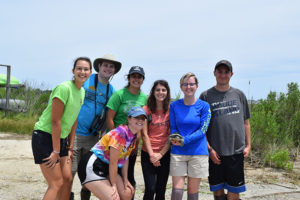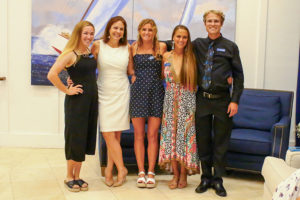
2019 CCRP Interns, L to R: Aileen Lavelle (front), Emilie Karovic, Tully Frain, Jamie Infanti, Amanda Lyons (undergraduate visiting researcher), Jess Klein, Zachary Hulmes.

2019 CCRP Interns, L to R: Aileen Lavelle (front), Emilie Karovic, Tully Frain, Jamie Infanti, Amanda Lyons (undergraduate visiting researcher), Jess Klein, Zachary Hulmes.
Coastal Conservation Research Program
We spent a productive and fun summer with the interns in the Coastal Conservation Research Program. The interns spent time on the marshes, beaches, and roads contributing to our ongoing monitoring projects; delved into independent research projects of their own; and gained new experience with data collection techniques, analytical approaches, and science communication to take forward in their careers. Their accomplishments over the course of the 10-week program were impressive, and they push us to learn and improve the work of our department.
Jamie Infanti* and Tully Frain*, both 2019 graduates of the University of Connecticut, tracked the success of and risk factors for birds nesting in the local marshes. Jamie, a second-year CCRP intern, continued research on Common Terns, exploring the relationship of vegetation and nest density to nest survival in a year with high predation pressure. Tully conducted surveys to identify territories and nests of secretive marsh-nesting sparrows, and characterized vegetation, elevation, and location of nests to improve future monitoring and conservation efforts. Zachary Hulmes+, a rising senior at the University of Rhode Island, examined spatial and temporal trends in road crossings of Diamondback Terrapins in relation to conservation measures on Stone Harbor Boulevard over a three-year period. Jessica Klein#, a rising senior at Stockton University, monitored a newly constructed nest mound for Terrapins to identify benefits and issues, and proposed modifications to enhance effectiveness, including a new barrier fence design she trialed. Emilie Karovic+, a rising junior at the University of Connecticut, explored saltmarsh pannes to learn more about the role they play in Terrapin movements, particularly for gravid adult females during the nesting season. Aileen Lavelle#, a rising junior at the University of California, Berkeley, modeled maximum water depth and temperature in the marsh over two years to examine inter- and intra-annual differences, and potential implications for marsh-dwelling species such as Terrapins.

2019 EE Interns, L to R: Sarah O’Sullivan, Brooke Knapick (Director of Education), Madison Sandquist, Reilly McFoy, Brandon Henry.
A Summer of Knowledge

2019 EE Interns, L to R: Sarah O’Sullivan, Brooke Knapick (Director of Education), Madison Sandquist, Reilly McFoy, Brandon Henry.
The Wetlands Institute’s Environmental Education Interns spent 12 weeks leading public education programs, while immersing themselves in the unique environment of the surrounding saltmarsh and barrier islands. They worked hard and through it all developed the skills they need to continue their careers in environmental education. Each year, interns are asked to develop and implement an education project of their choosing that is personally and/or institutionally beneficial. The deliverables from their projects leave a lasting impact on The Wetlands Institute and we hope you’ll stop by to see their education initiatives in action.
Brandon Henry* (Stockton University) enhanced the existing “A Night at the Aquarium” program by adding a short presentation and interactive bingo-style activity on UV induced fluorescence in saltmarsh biota, featuring local animals from behind-the-scenes in the Aquarium. Reilly McFoy* (Lebanon Valley College) redesigned six “Creature Feature” presentations in Nearpod, a web-based presentation software that allows the creator to add in real-time activities such as games, polls, drawings, multiple choice questions, and more. Sarah O’Sullivan+ (University of Rhode Island) designed a way to keep children and visitors occupied and engaged during program breaks through the creation of outdoor, portable activity boards centered around educational themes such as Osprey Hunting, I-Spy, Word Search, Marsh Filtration Cartoon, and a collaborative piece with Madison Sandquist to bring awareness to climate change. Madison Sandquist+ (University of Miami) focused on the emergent issue of climate change by creating a climate change “Science Feature” showcasing direct effects on local saltmarsh species, an interactive board game for children highlighting environmentally friendly choices that impact climate change, and, finally, a 3-panel informative poster display and live coral exhibit for the Aquarium.
*Position supported through The Larry L. Luing Family Foundation
+Position supported through The Barbara and Jim Summers Intern Endowment Fund
#Position supported through The Leff Family Foundation
